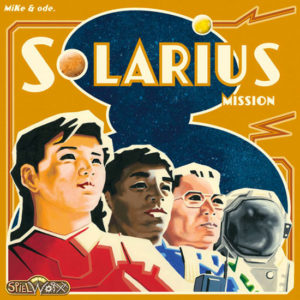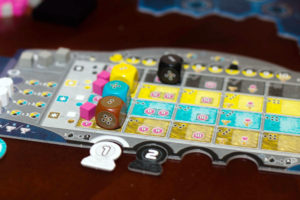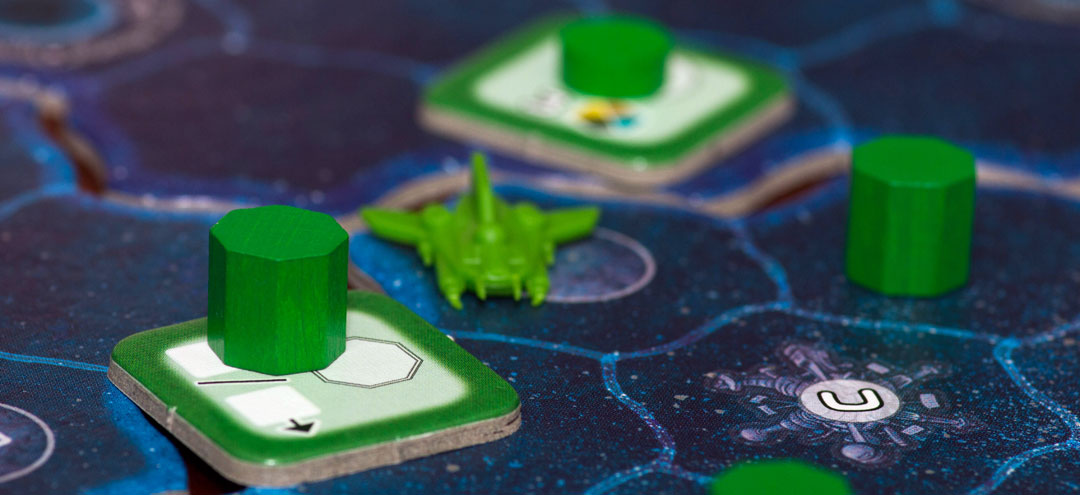 You are attempting to colonize various planets in outer space… stop me if you’ve heard this before. Solarius Mission starts from a familiar theme. But rather than trying to destroy other players, you will focus on becoming the most technically advanced empire in your bid to colonize far away planets.
You are attempting to colonize various planets in outer space… stop me if you’ve heard this before. Solarius Mission starts from a familiar theme. But rather than trying to destroy other players, you will focus on becoming the most technically advanced empire in your bid to colonize far away planets.
Solarius Mission touts itself as a 3X game. It takes the 4X model of eXplore, eXpand, eXpliot, and eXterminate and leaves off the extermination part.
Solarius Mission plays 2-4 players in about 90-150 minutes.
Gameplay Overview:
During each turn you will take two actions. The first action is dictated by the dice you select from the rondel. The power of the action depends on the number on the die. Some die faces show a “burst” symbol which means the power of the action depends on how far you have advanced that technology. There are four different action dice and you can choose one of the following actions:
- You can always choose to take resources of the color matching your die. You get a number of resources based on the number showing on the die.
- If you choose a black die, you can acquire fuel equal to the power of the action.
- If you choose a yellow die, you can acquire gold equal to the power of the action.
- If you choose a blue die, you can improve your technology of one (or more) of the die on your player board.
- If you choose a brown die you can push one or more dice to the next column on your player board. This makes room for more and better resources.

Any time you take a die that would give you three or more power; you also have to take a contamination cube. You have a place on your player mat for three of these cubes, but any additional cubes you acquire will be worth a negative point at the end of the game. You have to be an environmentally friendly space pirate.
After you take your primary die action you take a secondary action. These secondary actions come in two forms. First, you can move your ship a number of spaces up to its range. If you do, you can then:
- If you land on a planet, you can colonize it or harvest it for resources.
- You can build a space station if you have the needed resources.
- Complete a mission if you have a mission card in play and the needed resources.
These are the actions you’ll want to be aiming for throughout the game as they are the main generators of victory points. When you land on a planet, you reveal the requirement to colonize it and the number of victory points it is worth. Space stations give you additional abilities that trigger every round and when each subsequent space station is built. Missions come on progress cards and earn you a lot of victory points but, unfulfilled missions will lose points at the end.
You can also build outposts when taking these actions. These outposts have some restrictions, but allow you to get one-time bonuses that can really put you ahead.
If you decide not to move your ship, instead you can take alternate secondary actions, including upgrading the range of your ship or drawing/playing progress cards.
The progress cards have multiple uses. One side of them is a mission. But the other is a research that, if played, gives you an ability that other player do not have.
After each player takes 4 turns, the round ends. Space station abilities trigger and players put their action dice back in the bag. After the fourth round, the game ends. Points are scored for planets, space stations, and missions and for having technology improvements. The player who has the most points is the winner.

Game Experience:
When it comes down to it, you get to take 32 actions in a game of Solarius Mission. There are tons of ways to score points and you just aren’t going to have time to do everything you want to do. You build slowly to have more technology and more resources so at the end of the game, your actions become more powerful.
The thing I like best about Solarius Mission is being able to map out a couple of turns to fulfill a goal. If you want to complete a mission you may take a brown die to make more room for resources and use your secondary action to play the mission. Next turn you have to take a die to get resources, and then fly to the hub and complete it. If you are able to build an outpost you may get a bonus that starts you toward your next goal.

However, the fact that you only have 4 dice available on the rondel means despite your plans, it may be better to change tactics depending on what is available. You can always use the color-changing spot on your player board if you really need something that isn’t available, but it is a costly process. As much as I try to map out everything I’m going to do throughout the game, the dice changing make flexibility a very important trait. You may have to come back to the mission later because there is a different, more powerful, option that just became available.
There are some component concerns that are worth mentioning. The most important component to discuss in Solarius Mission is the rulebook. It is among the worst I’ve ever had the displeasure of trying to make sense out of. The layout is strange, the font is small, and most game mechanics just aren’t explained well. This game will take you some time to learn and you’ll be best off looking for other rules resources on BGG and other places to really learn the game. The rondel-spinner thing that you pick action dice from has to be glued together, so be prepared for a little arts and crafts to get going. And finally, in the initial print run the player discs were extremely small, although Spielworxx replaced those on request.
Moving on, I love the ability to use progress cards to give myself abilities that other don’t have access to. The fact that you start off playing by essentially the same rules as everyone else, but then can choose to play progress cards that allow you to customize your particular player for the strategy you want to go for.

That said, it’s also a reasonable strategy to not bother with any of those progress cards. Using one of your limited actions to just play a progress card can really feel like you aren’t making enough progress. Jetting around the map, colonizing every planet in sight can also be a winning strategy. Maybe you want to try to get some of every color to get the bonus points. However, planets of the same color have similar requirements to settle, so it can be easier to settle more planets of one color than trying to branch out and be an expert at everything.
As already discussed, there isn’t any combat in the game, but there is still some amount of player interaction. Mostly that comes from the map, as you may be competing with other players to colonize planets or complete missions at certain hubs. You are also competing with players for the same action dice on the rondel. While it isn’t a ton of interaction, it is enough to make it feel like more than a solitaire game.
Solarius Mission feels like a game of completing tiny sub-goals throughout the game. There isn’t a clear choice as far as I can tell on which ways are the best or most efficient to gain points throughout the game. Based on the cards you have or just what you want to try to do, there are plenty of reasonable options available to you. It feels like a sandbox game; every option is in front of you it and up to you which route you take.
Final Thoughts:

Solarius Mission is one of my favorite games from 2016. There is very little variance in the game, despite the presence of so many dice. It can be unfortunate if the dice on your turn aren’t exactly what you are looking for, but there are ways to mitigate those scenarios. And it is very rare that multiple dice aren’t good for you.
It seems rare these days to play a game where every option is a positive one. There isn’t any destruction. There aren’t rolls that do nothing for you. Everything you can choose to do will help you score points, you just have to determine which things will help you score points in the way that is most efficient.
Despite the rulebook and production issues, I recommend Solarius Mission to everyone, especially fans of heavier Euro games. It can be played in about an hour with two players but scales up to about 2.5 hours with four players. But Solarius Mission is a great investment of your time.
If you’d like to get a copy of Solarius Mission, it’s currently between printings, so you’ll have to try your luck on the secondary market.
Final Score: 4.5 Stars – A great game with an unfortunate rulebook and steep learning curve
 Hits:
Hits:
• Sandbox style game where any strategy can win
• Rondel and dice mechanic is unique way to limit available actions
• Modular setup with tiles and planets allow games to be different every time
Misses:
• The rulebook is miserable. You can’t learn this game correctly from it.
• Components aren’t great. Incorrect discs in the first printing and you have to glue the rondel.






















